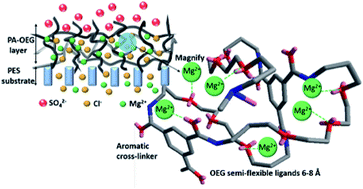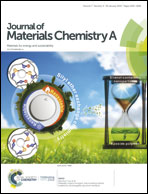Oligo-ethylene-glycol based thin-film composite nanofiltration membranes for effective separation of mono-/di-valent anions†
Abstract
Separation of monovalent and divalent anions is highly required in water treatment technologies for recycling concentrated brine resources, upgrading industrial separation processes and reducing the release of hazardous compounds into the environment. For the selective separation of monovalent and divalent anions, porous organic networks comprising oligo-ethylene-glycol units were finely tailored with porous structures, ion affinity and hydrophilicity. Enhanced cation affinity and tailored porous structures were achieved by using closely related oligo-ethylene-glycol-containing building blocks, including 1,2-bis(2-aminoethoxy)ethane (EDA), 4,7,10-trioxygen-1,13-tridecanediamine (DCA) and polyethylene glycol diamine (N-PEG). Thin-film composite (TFC) nanofiltration (NF) membranes were prepared by interfacial polymerization using oligo-ethylene-glycol-based amines with trimesoyl chloride (TMC) on a polyethersulfone support (PA@DCA, PA@EDA and PA@N-PEG TFC membranes). The sub-nanometer pore size of the PA@DCA film was larger than that of the PA@EDA film of 2 angstroms, and the PA@DCA TFC membrane exhibited a NaCl permeation 3-fold higher than that of the PA@EDA TFC membrane. Furthermore, the cation permeances of the oligo-ethylene-glycol-based membranes increased in the same order of cation affinity based on the valence of ions. These results indicated a translation of the properties of the oligo-ethylene-glycol units to ion-selective performances. Enhanced pure water permeance, faster NaCl permeance and high Na2SO4 rejection (more than 99%) were achieved at a reduced degree of cross-linking and a thinner thickness of the thin film layer. In terms of mono-/di-valent anion selectivity, the PA@DCA TFC membrane showed a performance 4-fold higher than that of the typically used commercial NF membranes, such as DOW NF 270. This strategy paves the way for microporous organic networks for the fabrication of nanofiltration membranes.



 Please wait while we load your content...
Please wait while we load your content...